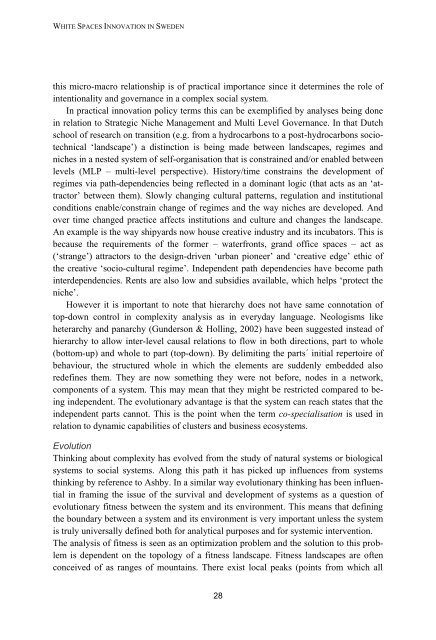White Spaces Innovation in Sweden - Innovation policy for ... - Vinnova
White Spaces Innovation in Sweden - Innovation policy for ... - Vinnova
White Spaces Innovation in Sweden - Innovation policy for ... - Vinnova
You also want an ePaper? Increase the reach of your titles
YUMPU automatically turns print PDFs into web optimized ePapers that Google loves.
WHITE SPACES INNOVATION IN SWEDENthis micro-macro relationship is of practical importance s<strong>in</strong>ce it determ<strong>in</strong>es the role of<strong>in</strong>tentionality and governance <strong>in</strong> a complex social system.In practical <strong>in</strong>novation <strong>policy</strong> terms this can be exemplified by analyses be<strong>in</strong>g done<strong>in</strong> relation to Strategic Niche Management and Multi Level Governance. In that Dutchschool of research on transition (e.g. from a hydrocarbons to a post-hydrocarbons sociotechnical„landscape‟) a dist<strong>in</strong>ction is be<strong>in</strong>g made between landscapes, regimes andniches <strong>in</strong> a nested system of self-organisation that is constra<strong>in</strong>ed and/or enabled betweenlevels (MLP – multi-level perspective). History/time constra<strong>in</strong>s the development ofregimes via path-dependencies be<strong>in</strong>g reflected <strong>in</strong> a dom<strong>in</strong>ant logic (that acts as an „attractor‟between them). Slowly chang<strong>in</strong>g cultural patterns, regulation and <strong>in</strong>stitutionalconditions enable/constra<strong>in</strong> change of regimes and the way niches are developed. Andover time changed practice affects <strong>in</strong>stitutions and culture and changes the landscape.An example is the way shipyards now house creative <strong>in</strong>dustry and its <strong>in</strong>cubators. This isbecause the requirements of the <strong>for</strong>mer – waterfronts, grand office spaces – act as(„strange‟) attractors to the design-driven „urban pioneer‟ and „creative edge‟ ethic ofthe creative „socio-cultural regime‟. Independent path dependencies have become path<strong>in</strong>terdependencies. Rents are also low and subsidies available, which helps „protect theniche‟.However it is important to note that hierarchy does not have same connotation oftop-down control <strong>in</strong> complexity analysis as <strong>in</strong> everyday language. Neologisms likeheterarchy and panarchy (Gunderson & Holl<strong>in</strong>g, 2002) have been suggested <strong>in</strong>stead ofhierarchy to allow <strong>in</strong>ter-level causal relations to flow <strong>in</strong> both directions, part to whole(bottom-up) and whole to part (top-down). By delimit<strong>in</strong>g the parts´ <strong>in</strong>itial repertoire ofbehaviour, the structured whole <strong>in</strong> which the elements are suddenly embedded alsoredef<strong>in</strong>es them. They are now someth<strong>in</strong>g they were not be<strong>for</strong>e, nodes <strong>in</strong> a network,components of a system. This may mean that they might be restricted compared to be<strong>in</strong>g<strong>in</strong>dependent. The evolutionary advantage is that the system can reach states that the<strong>in</strong>dependent parts cannot. This is the po<strong>in</strong>t when the term co-specialisation is used <strong>in</strong>relation to dynamic capabilities of clusters and bus<strong>in</strong>ess ecosystems.EvolutionTh<strong>in</strong>k<strong>in</strong>g about complexity has evolved from the study of natural systems or biologicalsystems to social systems. Along this path it has picked up <strong>in</strong>fluences from systemsth<strong>in</strong>k<strong>in</strong>g by reference to Ashby. In a similar way evolutionary th<strong>in</strong>k<strong>in</strong>g has been <strong>in</strong>fluential<strong>in</strong> fram<strong>in</strong>g the issue of the survival and development of systems as a question ofevolutionary fitness between the system and its environment. This means that def<strong>in</strong><strong>in</strong>gthe boundary between a system and its environment is very important unless the systemis truly universally def<strong>in</strong>ed both <strong>for</strong> analytical purposes and <strong>for</strong> systemic <strong>in</strong>tervention.The analysis of fitness is seen as an optimization problem and the solution to this problemis dependent on the topology of a fitness landscape. Fitness landscapes are oftenconceived of as ranges of mounta<strong>in</strong>s. There exist local peaks (po<strong>in</strong>ts from which all28
















